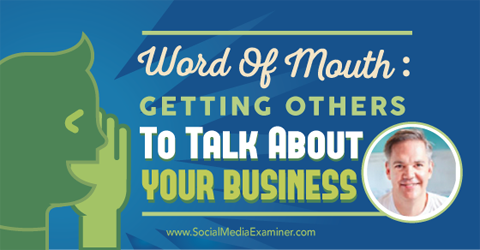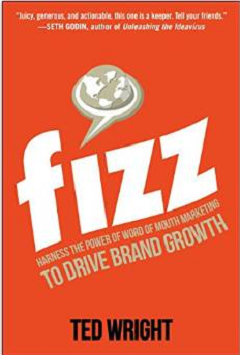 Do you want more people to talk about your brand or business?
Do you want more people to talk about your brand or business?
Want to discover how to get the ball rolling?
To learn about word-of-mouth marketing, I interview Ted Wright.
More About This Show
The Social Media Marketing podcast is an on-demand talk radio show from Social Media Examiner. It’s designed to help busy marketers and business owners discover what works with social media marketing.
In this episode I interview word-of-mouth marketer Ted Wright, author of the book, Fizz: Harness the Power of Word of Mouth Marketing to Drive Brand Growth. He’s also the founder of Fizz, an agency that specializes in word-of-mouth marketing. His clients include Intuit, Pabst Blue Ribbon, Verizon, Intel and many others.
In this episode Ted will explore word-of-mouth marketing.
You’ll discover why word-of-mouth marketing is important in the age of social media, as well as things you can do to get people talking.
Share your feedback, read the show notes and get the links mentioned in this episode below.
Here are some of the things you’ll discover in this show:
Word of Mouth
How Ted became interested in word-of-mouth marketing
Ted talks about when he attended the University of Chicago School of Business in 1999. At that time the computer lab was basically a windowless cave with 20 rows of 20 computers each, Ted recalls. Early one morning working in the lab, he noticed the ambient light was blue. It was because the Netscape screen was mostly blue, and that’s the site everyone used.

Fizz by Ted Wright.
After 20 minutes or so of searching fruitlessly and getting frustrated with Netscape, somebody leaned over and suggested Ted try Google, which he did.
Ted’s test search term was his mother’s name, Dr. Lynette Wright, a fairly famous medical geneticist. However, since they share the same last name as the guys who invented airplanes, most search engines easily got confused.
“Google returned my mother as the second search term, instead of eight pages deep, which was the norm for other sites,” Ted shares. He kept working and 20 minutes later, Ted noticed the guy next to him getting frustrated. So Ted leaned over and explained Google to him.
About four or five hours later, Ted finished working, stood up, looked around and noticed the light in the room changed from the ambient blue of Netscape to the ambient white of the Google screen.
Ted, who’s always trying to figure out how things work, found that very interesting. So during his second year at the University of Chicago, he blew apart the history, math, psychology and epidemiology of word-of-mouth marketing.
After graduation, Ted decided to start his own business. That company, which he started 15 years ago, is now called Fizz.
Listen to the show to discover the unique way in which Ted watched TiVo and Google get adopted.
The importance of word-of-mouth marketing
Ted defines word-of-mouth marketing as “identifying your influencers and coming up with a story that is interesting, relevant and authentic that ladders back to qualities of your brand and then sharing that story as much as possible.”

Word-of-mouth marketing is important in storytelling. Image: Shutterstock.
That’s the first part. The second part, Ted says, is “creating for your influencers as many opportunities as you can as a brand or a company for them if they feel like it to share your brand’s story with as many people as they would like to do so.”
Ted shares the word-of-mouth marketing campaign he ran for Pabst Blue Ribbon (P.B.R.) with the brand manager at the time, Neal Stewart. The goal was to get more people in America to drink P.B.R.
Ted identifies the three critical components of a story being shared:
- Is the story interesting to influencers so they will pick it up, study it and really understand it?
- Is it relevant to influencers’ audiences?
- Is it authentic the way they currently understand the brand and the category in general?
With all due respect to the people who make P.B.R, Ted says, they were never going to win by talking only about taste. So they decided to focus on what’s going on outside the can.
Ted explains how at the time (around 2000), most young adults who just hit drinking age were likely born in 1980 or earlier, and had a good chance of being the children of yuppies (young urban professionals). Yuppism (in the 1980s and 1990s) at its extreme is about having things just to have things. The children of yuppies appreciated these benefits while they were growing up. However, right after graduation, they rejected all of their stuff. This was happening in 2000, and became known as Hipsterism: a rejection of things and a rising importance of experience.
Therefore, Ted and Neal decided that as a brand, P.B.R. would celebrate people who were doing interesting things because they wanted to be doing them, not because they wanted to be seen doing them.
They found people who were interested in cool things such as bicycle races, hipster bartender golf tournaments and bands like Minikiss. They hired them to go to events they were going to anyway. Then if someone asked, they could talk about P.B.R. As a brand, they were the first ones to listen to people and be genuinely interested without asking for anything in return.
Fast Company recently named P.B.R. as one of the biggest turnarounds in the last 20 years
Word of Mouth: Getting Others to Talk About Your Business

No comments:
Post a Comment